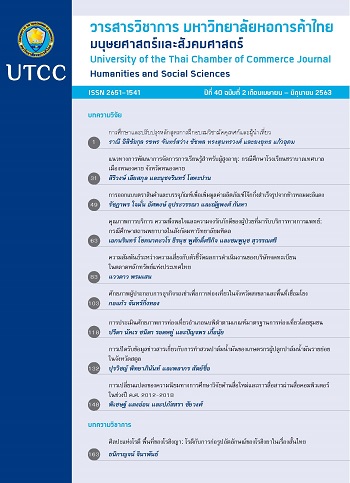Brand and packaging design for adding value of instant red jasmine rice porridge
Main Article Content
Abstract
The objectives of this study are to design the brand and package of instant red jasmine rice porridge for the organic agricultural community enterprise promotion group in U Thong district, Suphan Buri province and to study of satisfaction toward the brand and packaging prototype. After brainstorming, three styles of brand and four styles of package were designed by the graphics software. Afterwards, the satisfactions in all of the designed styles were evaluated on 234 consumers, 15 entrepreneurs and 15 brand and packaging design specialists using a self-administrative questionnaire. The accidental sampling technique was used for consumers while purposive sampling was applied for entrepreneurs and specialists. The results showed that all groups of the evaluators scored the highest overall satisfaction especially for its identity for the Style 2 which symbolized by a picture of a farmer who is holding a sickle with a symbol of number nine in Thai style as an inspiration. This implied the story of farmers who have been planted and processed rice products by themselves in every steps. For packaging, all evaluator groups scored the highest overall satisfaction for the Style 2, followed by Style 3 and 1, respectively. Style 2 is created by emphasizing on simplicity. In addition, an image of the product stands out by using pastel colors. Therefore, Style 2 got the highest score due to its color and art composition.
Article Details
ลิขสิทธิ์ของบทความ
ผลงานที่ได้รับการตีพิมพ์ถือเป็นลิขสิทธิ์ของมหาวิทยาลัยหอการค้าไทย ห้ามมิให้นำเนื้อหา ทัศนะ หรือข้อคิดเห็นใด ๆ ของผลงานไปทำซ้ำ ดัดแปลง หรือเผยแพร่ ไม่ว่าทั้งหมดหรือบางส่วนโดยไม่ได้รับอนุญาตเป็นลายลักษณ์อักษรจากมหาวิทยาลัยหอการค้าไทยก่อน
References
ดวงฤทัย ธำรงโชติ. (2550). เทคโนโลยีภาชนะบรรจุภัณฑ์. กรุงเทพฯ: โอเดียนสโตร์.
มยุรี ภาคลำเจียก. (2556). การพัฒนาและการออกแบบบรรจุภัณฑ์. ใน ศุภณี เรียบเลิศหิรัญ (บรรณาธิการ), เอกสารการสอนชุดวิชา ความรู้ทั่วไปเกี่ยวกับบรรจุภัณฑ์ หน่วยที่ 8-12 (น. 10-1 – 10-100). นนทบุรี: มหาวิทยาลัยสุโขทัยธรรมาธิราช.
อาวิน อินทรังษี. (2559). การออกแบบนิเทศศิลป์กับการสร้างแบรนด์. กรุงเทพฯ: โอ เอส พริ้นติ้ง เฮ้าส์.
Aaker, A. D. (1996). Building strong brands. New York, NY: The Free press.
Kauppinen-Räisänen, H. (2014). Strategic use of colour in brand packaging. Packaging Technology and Science, 27, 663-676.
Kotler, P., & Armstrong, G. (1991). Principle of marketing. Upper Saddle River, NJ: Prentice-Hall.
Li, S., Wu, B., Fu, W., & Reddivari, L. (2019). The anti-inflammatory effects of dietary anthocyanins against ulcerative colitis. International Journal of Molecular Sciences, 20(10). doi:10.3390/ijms20102588.
Luo, D., Yu, L., Westland, S., & Mahon, N. (2019). The influence of colour and image on consumer purchase intentions of convenience food. Journal of the International Colour Association, 24, 11-23.
Meyers, H., & Lubliner, M. J. (1998). The marketer's guide to successful package design. New York, NY: Mcgraw-Hill.
Pensasitorn, W. (2015). The use of images in graphic design on packaging of food and beverages. Journal of Economics, Business and Management, 3, 1159-1163.
Schuldt, J. P. (2013). Does green mean healthy? Nutrition label color affects perceptions of healthfulness. Health Communication, 28(8), 814-821.
Silayoi, P., & Speece, M. (2007). The importance of packaging attributes: A conjoint analysis approach. European Journal of Marketing, 41. 1495-1517.


